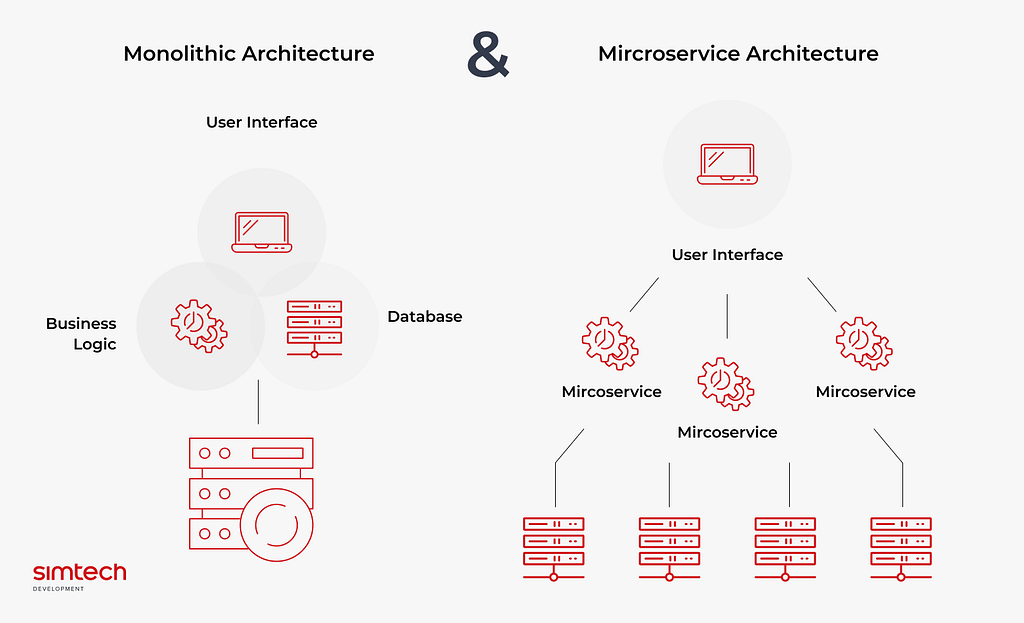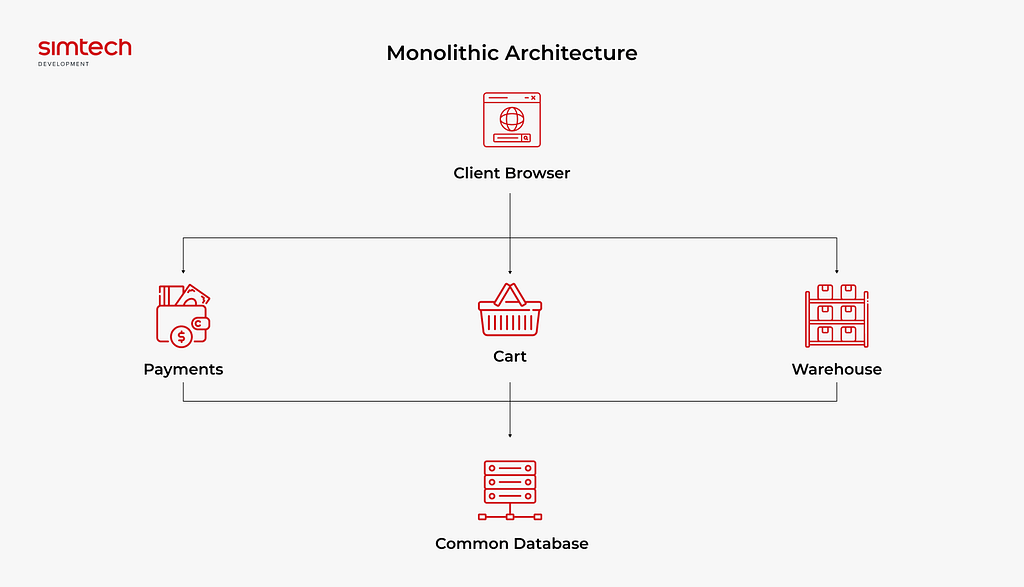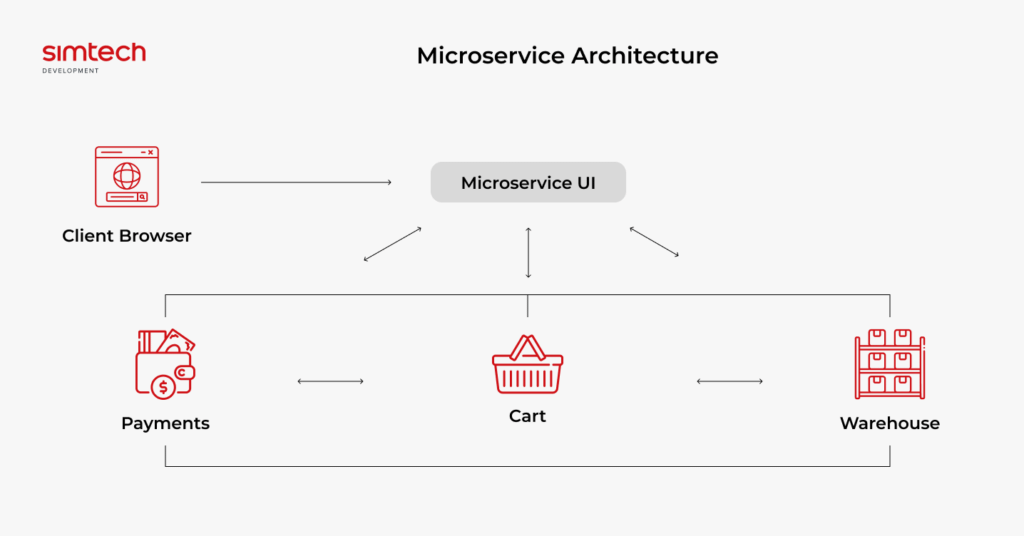The evolution of software has led to the emergence of two opposing approaches to website architecture – monolithic and microservice. If you are a developer or a specialist responsible for creation and functional development of an online store, this article is for you. Here, Andrew, CTO of Simtech Development, shreds light on the features, advantages and disadvantages of each approach. This paper will also help you understand which approach is optimal for your business.
Architecture for an application is like the foundation for a house. It plays a crucial role in defining and solidifying the structure, relationships, and organization of system components. The choice of architecture approach has a direct impact on the performance, reliability, and scalability of your eCommerce website.
Andrew, CTO of Simtech Development
What is the difference between monolithic architecture and microservices
When I talk about architecture, I mean a certain approach to building an application. In a monolithic architecture, the database, business logic, and user interface are covered within a single code base. The microservice model has the opposite structure: each component is independent and represents a separate application with its own set of files, libraries, configurations, resources and, of course, the code base.
Let’s explore each of these approaches.

Monolithic application architecture
Monolithic architecture has been widely used in the past, and examining its strengths and weaknesses can provide valuable insights for designing and building new systems. With the rise of microservices, it is important to understand how monolithic architecture differs and how it may impact system design and development decisions.
What is monolithic architecture

A monolithic architecture is an application built as a single unit with a single code base. Interaction with the service occurs through the API or web interface.
If we talk about eCommerce, then most online stores are monoliths. This model arose first (in 1990 – 2010), and most entrepreneurs who created their websites based on this architecture have been developing projects within its framework for years.
Advantages of monolithic architecture
You should not think that monoliths (or, as they are also called, monoservices) are the initial stage of evolution in website design and therefore have lost relevance. If this was really so, Shopify would not have chosen it. So what’s good about this approach?
Ease of development and technical support
A single code base allows you to quickly launch a project and add the necessary add-ons as needed. The developer does not need to worry about inter-process communication – all components are located inside the monolith in one repository.
Simplified Deployment
The application is deployed on a single server or virtual machine. This makes the process of releasing, installing and activating software quick and convenient.
Simple communication
Within a monolith, communication between components occurs directly, without the use of remote procedure calls (RPC) or inter-process communication (IPC). High interaction speed gives the site high performance.
Scaling Variability
An application with a monolithic architecture can be expanded and scaled both horizontally by adding additional resources, and vertically improving the performance of the server and the application itself.
Easy updates
Upgrading a program on a monolithic architecture can be easier than on a microservice architecture, because in the first case you only need to update one code base, in the second – the base of each microservice.
High team expertise
When a development team works in a monolithic technology stack and uses one programming language, it hones its skills every day and becomes truly professional – even if it consists of employees of different skill levels. Experienced senior specialists pull middle specialists behind them, and they pass on knowledge and experience to juniors. Therefore, a business owner can hire a team of employees of different grades.
Disadvantages of Monolithic Architecture
A website on a monolith is easy to use, but it also has disadvantages. Understanding the limitations and challenges of monolithic architecture can help in making informed decisions about system scalability, maintenance, and future development efforts. Let’s look at cons in detail!
Gradual complication of the project structure
When a project grows and develops over several years, it becomes unclear which parts of the code are responsible for which functionality. And this ultimately leads to excessive interdependence of elements when the development of a new feature requires changes in different functional blocks.
High vulnerability
There is virtually no isolation in a monolith: a problem or error in one of the add-ons can slow down or make the entire program stop running. Such incidents result in service interruptions and may affect all active users.
Limited scalability
A monolithic system does not allow capacity expansion for individual components. For example, if the performance of the application’s communication functions decreases due to increased traffic, additional resources will have to be provisioned for the entire monolith. This is not rational from the point of view of using capacity, but there is no other way.
Difficult to maintain
Monolithic applications often have a large amount of code, making them difficult to understand and maintain. Imagine that a new developer comes to a project, they need to add a feature, but see 10 thousand lines of code in the database. How much time do you think the developer will spend on implementing a seemingly simple task?
Lack of technological choice
The capabilities of monolithic applications are limited by the technology stack used during the development and deployment of the application. When a website is based on one programming language or framework, using other languages or frameworks will be difficult or even impossible.
Thus, we figured out that in a monolithic architecture, all add-ons and features are interconnected. The application is built as a single unit, where the components resemble links in a closed chain. The connections between them are so strong that the slightest change will affect the operation of the entire application.
Monolith is ideal for those who need to quickly and relatively easily develop an application. The task will be significantly simplified if your company has an IT department, or you can entrust this task to an IT company with a focus on eCommerce development.
Microservice application architecture
Now let’s move on to another common approach to application design. We’re talking about microservices that have become the “antipodes” of monoliths.
What are microservices?

A microservice architecture is an application that is assembled from separate, independent add-ons or services. Each of them has its own logic, database, and code language, and they interact via a network using protocol-independent technology.
Advantages of microservices
Microservices as an architecture emerged about 10 years ago from monoliths (approximately in the early 2010s). Developers love them because each of the services is focused on a specific function, which can be worked on by a separate group of specialists. Netflix, Uber, Airbnb and Amazon have deployed their websites using this model. Let’s see what pros microservices offer to developers.
High speed of development and implementation of new functionality
Microservices allow developers to work on individual services independently of each other. It takes a couple of days to become familiar with the application: a specialist gets a task, quickly dives into it, makes a product version, tests it, and releases it.
No limitations in the technology stack
Microservices can combine different technologies and programming languages. One can be written in Java, the other in Python.
High scalability
Microservices break an application into small, independent components, each of which performs a specific function. This allows you to horizontally scale individual services and flexibly manage resources.
High application performance
As users or requests for an application grow, microservices can be added by hosting them on additional servers. You can easily manage the load and distribute traffic.
Saving on hiring employees
Using microservices allows you to outsource some of the work. This creates more freedom both in technology and in specialists. What does this give to the company? The ability to optimize costs associated with the selection of personnel and contractors.
Disadvantages of Microservices
Understanding the drawbacks of microservices allows architects and developers to make informed decisions about whether to adopt this architecture for a particular project. It helps in evaluating its suitability for the specific requirements and constraints of the system. Organizations can proactively address these issues and mitigate the associated risks before they impact the development and operation of the system. Awareness of challenges enables better planning for the required skill sets, tools, and infrastructure. Let’s explore the bad side of microservices.
High development cost
To successfully create, develop and support microservices, decent financial resources are required. You need to take into account the costs of renting servers or cloud computing, software licenses, a large number of integrations and configuration for communication between services.
Complexity of development and maintenance
Creating an architecture of multiple microservices, especially in the context of ecommerce microservices, is technically more complex than developing a monolithic application. It requires coordination, data harmonization, and monitoring of the operation of all services individually and combined. More potential vulnerabilities arise, and testing and debugging each component can take a lot of time.
Imagine a situation: one microservice has broken down. And IT specialists immediately face a lot of questions:
- How can I now exchange data with other services?
- How to recover lost information?
- How will other components work if their data is being sent through the one that has failed?
The business owner will need a decent staff of high-level DevOps engineers who will know the logic of each microservice like the back of their hand.
Increased load on infrastructure
Since each service in the architecture requires its own resources, the overall load becomes impressive. This can lead to reduced site performance, delays in request processing, and problems with service availability.
Threat of data loss
When transferring data from one microservice to another via the IP protocol, there is a risk of information loss. Linking the logs of one machine with the request logs of another will require the time and effort of a team of DevOps engineers, who must ensure the configuration of connections between services, monitoring of data transfers, integrity and microservices security.
High developers’ cost
To create a microservice, you will need a team of competent specialists who speak different programming languages and know what technologies and tools to develop and maintain the architecture with.
So what’s the bottom line? Microservice architecture is an approach in which the application is divided into components, and each of them performs a specific function and operates autonomously. Services communicate via APIs and can be developed, deployed, and scaled independently of each other.
Microservices are suitable for online business players planning to implement a federal or international project. Those who have a team of IT specialists with different technology stacks and competencies. An alternative option is to outsource the team.
Key differences between monolithic architecture and microservices
Before you settle on one approach or another, analyze and evaluate their key characteristics. To make it easier for you, we have collected them in a table.
| Monolith vs. Microservice | |
| Monolith | Microservice |
| The functionality of the application is a single module | The functionality of the application is divided into microservices independent of each other |
| Components interact with each other through built-in mechanisms within one system | Microservices communicate with each other via API |
| Uses a single technology stack for the entire application | Each microservice can use its own technology stack |
| The application is written in one code base | Each module is written in its own code base |
| Application development, testing and deployment are completed as a single unit | Each microservice is developed, tested and deployed independently of the others |
| Application deployment occurs in one environment | Application deployment is a software package with platform-isolated code |
| Any modification affects many functions and the application as a whole | Only the required service or function is modified, which does not entail changes to the product |
| Single point of failure. Failures affect the entire application | Isolated failures. High fault tolerance |
| Direct function calls. Easy communication and data exchange | More resources are required for data coordination and consistency |
| You need to scale the entire application at once | Individual microservices can be scaled |
| Requires less planning initially, but management and maintenance will become more complex as time passes | Requires more planning initially, but management and maintenance become easier over time |
| Low investment at the start, increasing maintenance costs in the long term | More investment in project development than a monolith. Cost reduces in the long term |
| Suitable for developing websites with a simple centralized structure, prototype, MVP for an eCommerce project | Suitable for developing large applications that need to constantly scale |
Hybrid architecture
By the way, there is one more model that is found in eCommerce projects. We are talking about hybrid architecture. It becomes a compromise between microservices and a monolith and comes in two versions:
Hybrid monolith
The main part of the application functionality is implemented as a monolith, but microservices are used for some parts of the application. For example, a website can be implemented as a monolith, and a mobile application can be a separate microservice. This combines ease of development with the ability to scale individual components.
Microservice modules
A monolithic application is broken down into individual functional components that are implemented as microservices. However, some functions or services remain inside the monolith.
Hybrid architecture allows you to combine the advantages of both approaches. Typically, it is used for gradual migration from a monolith to a microservice architecture.
Here is an example: we are currently working with a federal network of optical stores. The online store was created on a monolith more than 10 years ago, and recently communication with warehouse accounting systems has been disrupted, the site began to crash.
Business owners came to Simtech Development with this problem and voiced it at a meeting with experts: maybe it’s time to switch to microservices? The solution is fashionable, advanced, and should help.
We also discussed business development plans: in the next few years, the client wanted to launch a marketplace, also using microservices.
Now, it’s time to sort everything out:
- The hype around microservices does not mean that the solution is universal, and redesign does not automatically fix problems.
- Moving from one platform to another is a labor-intensive, time-consuming and expensive process that may ultimately not bring the expected results. Why complicate everything so much when you can build a small microservice next to the monolith, output some of the data there, and communication between the components will be established.
- Talking about the above-mentioned client, launching a marketplace using microservices is impractical: with 20 thousand products in the catalog and plans for gradual scaling, it is simply not needed. The site won’t require such powerful performance, a large abundance of components and a large development team with DevOps engineers. Then why pay more?
Creating a marketplace on a monolith can take from six months to a year, but developing a website on microservices will take twice as long. The risk that the niche will be occupied by competitors is extremely high.
To keep it to a minimum, it is better to launch an MVP (Minimal Viable Product). The basic version of the site is enough to check the viability of the project, collect feedback from clients, work out objections and adjust the strategy, and when the adaptation stage is successfully completed, it will be possible to gradually grow the functionality.

Need more details about Laravel-based development?
What works best for you?
Before choosing an architecture for your project, formulate your expectations: traffic, integration with accounting systems, and scalability. Below are more subjects to think about.
Monolithic application architecture is suitable for online stores or marketplaces:
- with a simple and centralized structure,
- with project deployment on one server,
- with priority in simple development and technical support,
- with the desire to quickly launch a marketplace MVP without complex integrations and many services.
Microservice architecture is suitable for online stores or marketplaces:
- expecting a large volume of traffic and orders (Airbnb-level project);
- with technological heterogeneity of components;
- that need not only standard integrations with third-party services (payment systems, delivery systems, inventory management, or CRM), but also more complex ones. For example: a system for returns and exchanges of goods, management of social media, advertising campaigns, and loyalty programs.
Conclusion
When developing a large eCommerce project, you should pay special attention to website design. It can be built on a microservice or on a monolithic architecture. And each of these models has their own pros and cons.
Microservices offer scalability, flexibility, and technological diversity, but developers will face complex communication between components and complex system maintenance.
Monoliths are simpler, more efficient to develop, and are ideal for MVP, but you will have to take into account the difficulties in scalability and deployment.
What to choose is up to you. Focus on:
- company budget,
- scale and business logic of the project,
- availability and scalability requirements,
- availability of your own IT team and its experience,
- willingness to partially or completely entrust the development of the project to IT contractors.
If you need support, contact the Simtech Development experts. We will advise on the architecture that will be optimal for your online business and create an online store or marketplace in accordance with the best international practices.

